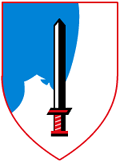188th “Barak” (Lightning) Armored Brigade
During the Yom Kippur War, it played an important role defending Israel’s border against the Syrian attack in the southern Golan Heights. 112 soldiers were killed in action, including the brigade commander. The brigade was almost completely destroyed. The main Syrian attack at 14:30-14:50 PM, confronted by the newly positioned 74th Tank Battalion, under the command of Lt.Col. Yair Nafshi. Nafshi moved his battalion position 1.5 km forward from its previous defensive position, a maneuver that saved his men and machines from the Syrian artillery barrage. His was the only remaining tank force, equipped with 36 Israeli modified Centurion tanks to fight the Syrians for 3 continuous days, until reinforcement and reserves were moved into positions. His battalion was reinforced with a tanks company from the 53rd battalion. After 4 days of fighting, his battalion was reduced to 5 operational tanks. More than 102 soldiers and officers died defending the southern Golan Line, from reinforced points (bunkers) 107 to 114. For his gallant, professional and courageous behavior during the war, Yair Nafshi received Israel’s second highest decoration, the Medal of Valor. He retired from the army with the rank of Brigadier General.
During the battle, Lieutenant Zvika Greengold, who had arrived unattached to any unit, fought off attacks with his single tank until help arrived. “For the next 20 hours, Zvika Force, as he came to be known on the radio net, fought running battles with Syrian tanks—sometimes alone, sometimes as part of a larger unit, changing tanks half a dozen times as they were knocked out. He was wounded and burned but stayed in action and repeatedly showed up at critical moments from an unexpected direction to change the course of a skirmish.”
#
The attack opened with damaging air raids by Syrian Sukhoi fighter-bombers. The Syrians then advanced on the Golan Heights on a wide front, with the 5th, 7th and 9th Inf.Divs. leading-each with some 200 tanks under command-and the 1st and 3rd Armd.Divs. and several independent brigades following them, ready to exploit local success. In all the Syrians fielded some 1,260 tanks. Facing them on the ‘Purple Line’ Defences were one Israeli infantry brigade, the 188th (‘Barak’) Armd.Bde. with about 100 tanks and 44 SP guns; and parts only of the famous 7th Armd.Bde., whose full strength was some 105 tanks. The 7th held a line from the Lebanese border to Kuneitra; the 188th, a front of 40km (of much easier tank country) from Kuneitra south to the Jordanian border. The Israeli tankers were thus immediately outnumbered three to one, and at some points during the battle which followed the odds would be 12 to one.
Over a battlefield which the Israelis later called ‘The Valley of Tears’ the 7th Armd.Bde. bought time for the reservists to be mustered. The Syrians did not have the walk-over they expected. The Israelis had prepared ‘tank ramps’ from which the lank guns had ranged in on every feature of the plateau. They took heavy toll of the mine-clearing and bridge-laying tanks which led the Syrian advance; but the mass of enemy armour, supported by very heavy artillery fire from 130 guns, could not be stopped, and rolled through the ditches and minefields. In the north the 7th, aided by rougher terrain, managed to counter-attack with some success, holding its positions during night battles; but in the south the 188th Armd.Bde. was overrun. By dawn on 7 October Syrian units overlooked Israeli towns on the Sea of Galilee.
That the reserves arrived in an orderly way, ready for battle, was largely the work of Maj.Gen. Dan Laner, a reserve paratroop officer. Hurrying from his kibbutz, he set up a command post at 24 Arik Bridge, and from there he put tanks into units as and when they arrived, and sent them up on to the hills. In all, four reserve armoured brigades-the 79th, 14th, 17th and 19th-were rushed up to plug the gap in the ‘Purple Line’, entering battle squadron by squadron as available. By nightfall on 7 October the front was stabilizing. Laner’s handling of the crisis proved that the reservists system worked.
The continued success of the 7th Armd.Bde. in holding the northern sector led to it being left 10 get on with the job while attention was concentrated on scaling and reversing the Syrian breakthrough near Rafid. Thus it was that by 9 October the exhausted survivors of this superb unit were at the point of collapse. At the last moment some 13 tanks of the rebuilt 188th Bde. arrived to support them, throwing back the latest Syrian attack. Just seven tanks of the 7th Bde. ‘s original 105 were still running. For four days the brigade had held off repeated attacks by vastly greater forces, and had destroyed some 460 enemy AFVs.
On to October the reinforced 7th and 188th Armd.Bdes. led an Israeli counter-offensive north of Kuneitra, and Laner’s 19th, 20th and 79th Armd.Bdes. advanced in the south. A great salient was forced into the Syrian lines, bringing Israeli guns within range of Damascus. On 13 October the Israelis severely punished a counter-attack by the Iraqi 3rd Armd. Division. The Jordanian 40th Armd.Bde., attacking on the Iraqis’ left flank, were hit hard on the 16th and 18th. This was the last major clash in an armoured confrontation which cost the Syrians and their allies a total of some 1,200 AFVs-though at heavy cost to the Israelis. The symbol of victory on this front was the recapture of Mt. Hermon in a joint assault by paratroopers and the ‘Golani’ Bde.
